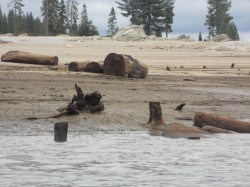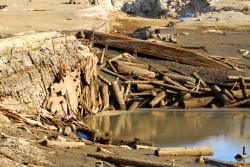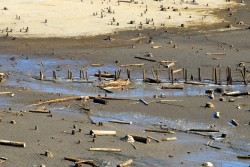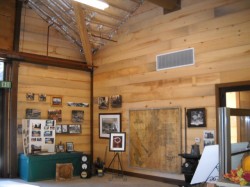The Story of Sinker Lumber by Jeff Young
The first sawmill came to the Pine Ridge area in the early 1850s, and by the 1880s several other sawmills were being operated around the local area. Around 1890 a sawmill was built on Stevenson Creek and within a couple of years an earth and rock dam was spanning the creek to provide water to a flume that would carry lumber to Clovis. This operation was run by Lewis P. Swift and C.B. Shaver who had several steam donkeys supplying logs to this large mill. Early on, the logs were skidded directly to the mill pond and then floated to the sawmill. It was common knowledge to any man who worked around logs in water that a few logs refused to float. Try as they did to keep these logs afloat by hooking sinkers to floaters many of them still made their way to the bottom. The first logs on the bottom of the old Shaver mill pond would have sunk in the early 1890s.
Upon completion of the flume, transportation of milled lumber to the valley floor became quick, around 6-7 hours, and after years of this highly efficient milling operation the local timber was cut out. This necessitated the building of a railroad and in1903 logs were being accessed beyond the Shaver basin. The lake terminal for the Shaver Lake railroad was on a point of land that stretched some distance out into the mill pond. Over the course of the next dozen years, millions of board feet of timber were dropped into the pond from an elevated trestle over the water.
On the edge of this pond was the town of Shaver, a company town that supplied the workers with their everyday needs—except for alcohol, as Shaver was a dry town. Here was where the blacksmiths made the thousands of iron pins-and-rings that were used to raft the logs together before they were hauled across the lake by the steamboat Michigan.
By the teens, financial difficulties burdened the operators of the Shaver mill and the severe winter of 1914-1915 destroyed large portions of the flume. This put an end to the sawmill operation and the mill, town, and railroad were abandoned. Over the next few years the mill pond saw only fishermen until Southern California Edison Company purchased the timberlands and began developing the area for hydroelectric power. The sawmill was put back into service in 1919 milling sinker logs to provide lumber for this endeavor.
By 1927 the dam was completed and the new Shaver Lake was filled and for 30 years little thought was given to the old sinker logs lying on the bottom of the old mill pond. In the late 1950s two energetic Edison employees devised a plan with Bud Yancey, owner of the sawmill in Tollhouse, to recover some of these logs to be milled. Keith Tobin and Jack Young began salvaging logs in 1959 with an A-frame barge floated by 16 oil drums. Their first attempt at raising sinker logs was accomplished with hand winches. This worked well and they were able to transport several hundred thousand board feet of sugar pine and white fir to the lake’s edge where the logs were loaded and trucked to Tollhouse.
By the second season of salvaging, some changes had been made. The hand winch proved too fatiguing and somewhat dangerous so they devised a lift system that incorporated a Briggs and Stratton engine, Nash Rambler transmission, and a two-speed Dodge Power Wagon winch. This proved very efficient and upped their production but after another year of logging it was evident the ratio of fir to pine was too high. Yancey Lumber Company was losing money on the fir and not making up for it on the much more valuable sugar pine. The operation was shut down and the sinker logs were again forgotten.
As a child I grew up with the story of sinker logs and Jack Young was my uncle, and my father, Doug, frequently helped his brother Jack and Keith recover logs. In the late 1970s the low water exposed the old dam and these sinker logs became visible. This got me thinking and when the old dam was exposed again in the 1980s I was prepared to go after the sinker logs. A close friend of mine, Walter Richards, and I salvaged the original barge off of Redinger Lake where it had been used as a boat dock for the last 20 years. Thanks to the ingenuity of Walter, the barge was refit with a new gas engine, 3-speed transmission, and Dodge Power Wagon winch.
In 1987 we recovered two log truck loads of logs and had them milled. The lumber was exceptional. Unfortunately, this would be the last time that the lake was low enough for the logs to be easily found. It was obvious if we were to recover any more logs we would have to get creative.
I looked into salvage divers but the cost and the risk were extremely high. Several ideas were bounced back and forth over the phone between my brother, Dan, who lives in Oregon, and me. We arrived at a system of trolling with large log tongs supported by a hand-held rope, as well as a heavy cable. The scheme looked good on paper and our first attempt was made during a light March snowstorm in the dark. Doing it after dark allowed us good viewing of the images the underwater camera, which was hooked to the log tongs, showed. Thirty minutes of experimentation produced a hook-up. The next day the 120 feet of 5/16” cable was hooked to Sierra Marina’s recovery barge, and our first log, a 24” in diameter fir log 20 feet long was winched to the surface.
Having proven our system would work, the 40 year old barge was refit once again to hold 150 feet of cable on a 12 volt, 12,000 lb. capacity industrial grade winch. This setup was powered by several large deep-cycle batteries, a heavy-duty charger, and a Honda generator providing the amperage to lift logs weighing 7,000 lbs. in the water to the surface. Some of the logs weighed nearly 30,000 lbs. out of water. This has proved to be a very efficient operation with techniques evolving over the years to where very few logs are lost.
Up to 3 dozen logs are recovered each year at depths of up to 115 feet. The logs are milled at a local one-man sawmill and all the sinker lumber stays in the local area. Some of this lumber can be seen on the walls of the museum. Come visit my sawmill, just over the hill from the museum.
Jeff Young





I would love to have a piece of a Sinker, made into a little box, or vase, or sculpture….know who I could contact to get a piece of this Shaver Lake history?
E-mail me at [email protected] and we can try and get you in contact with someone that would have that information.
What is the name of the sawmill at Herndon & Highland in Clovis and what purpose did it have to the flume from Shaver Lake?